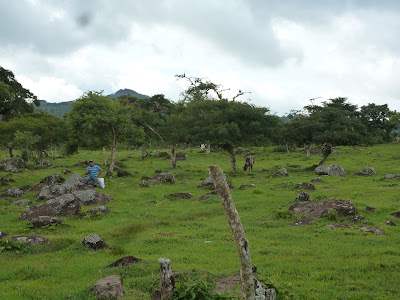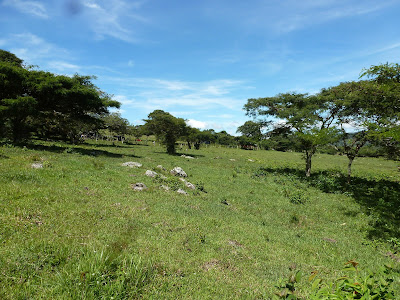Today really proved to be the big day. By prior arrangement I was to start by meeting Juan Carlos Sanchez at the Hospital Victoria Motto where he works in the pharmacy as a technician. I had met him on Tuesday during the meeting with the sanitary committee of which he is the coordinator.
 |
| Juan Carlos Sanchez - My Guide for the Day |
I got up at around 5:30, cleaned up and left the house at 6:30 and walked to the south end of town where the hospital is located. The day begins early down here and by 7:00AM the streets of the city where lurching to life. The sidewalks were full of students in uniform heading to school and people on their way to work. I met Juan outside of the emergency department thinking that we're going to drive back to Sasle in his car. That was a bit presumptuous on my part. Instead, we would be taking the bus together. The bus did not leave until just after eight so we had an hour or more to kill. We grabbed a cab and headed to the north end of town where the bus stop is located end went over to one of the local comedores (a small storefront restaurant quite common down here) where we had breakfast. Now breakfast down here is not like breakfast the way we are used to up by us. This is not rice crispies, toast or eggs; this would look very much like a dinner meal to most of us. We had rice, beans, a watery pasta , and a piece of steak in a red sauce with onions. After we finished breakfast we did a little shopping in what looks to be the city's main open-air marketplace.






We picked up items for what would be our lunch. By the time we were finished with our breakfast and shopping it was almost time to get the bus. We boarded and within minutes we're off on our way north to Sasle. Unlike the previous day when Jairo and I had gone by car the bus route was less direct and took a number of detours to drop off and pick up people. Once again, a number of these roads were not paved and the bus did a fair amount of bumping and bouncing. In addition, the bus made a number of unscheduled stops when it encountered a bus traveling in the opposite direction (see the entry "Odds and Ends number one"). In contrast to the 35 minutes it took to go by car with Jairo the bus took the better part of an hour. One of the most amazing aspects of the trip was when the bus navigated the small bridge over the stream at the village of San Angel. The bridge itself seems barely large enough to accommodate a car let alone the bus and as always there are people downstream from the bridge washing their clothes in the stream.



We eventually arrived at the bus stop near the turn off for the school where we were met by Francisca and Raquel. They and Juan Carlos were to be my guide for what proved to be a fairly comprehensive hiking tour of Sasle.
 |
| New School at Sasle |
 |
| Tour Guides - Francisca and Racquel |
After we exchanged greetings we set off up the road for Juan Carlos' house to drop off the groceries and to meet his family. He gave me a brief tour of his property, which he currently rents but is seeking to purchase. He is a truly amazing man, working a full time job (often 24 hours in a row shifts) in the hospital pharmacy then going home and improving his property which is, essentially, a mini-plantation. He has pigs, a small plot of corn, several coffee trees and numerous fruit trees. He also has a beautiful ornamental garden with roses and zinnias and even a number of topiary trees which he is pruning into artistic shapes. Quite the guy.
 |
| Ornamental Garden - Zinnias |
 |
| Coffee Beans Drying |
 |
| Coffee Beans on the Tree |
We set out directly from Juan Carlos' house for our "walking tour" of Sasle. "Expedition" might be a better word, perhaps. I guess "trek" suits it best. We walked past the school and up one of the unpaved roads into the back country. The terrain here is based upon volcanic mountains that have undergone erosion. The soil is coarse, black and relatively sparse. The fields are pocked with stones and boulders. The roads themselves are essentially naturally paved concourses where horse and human traffic have either pounded the stones into a relatively uniform depth, or, the road itself winds to avoid large boulders and to utilize this natural paving. Unlike Panama, despite abundant rain, there was relatively little mud. The simple fact is that the soil layer is just too thin for mud of any great depth to form. Also, unlike Panama which is at sea level, this is relatively high country and over the course of what was probably a 15 km hike we peaked out at 3900 feet (Yes, I got the GPS up and running after all). Actually, the geography, and even the vegetation, is similar to what we have here in the Catskills.




The primary purpose of the tour was to survey the homes in the community mainly so I could get a feel for the layout of things and to formulate an approach as to how to provide latrines for them. I had hoped that the homes would be arranged in clusters so that we could install multi-unit latrines that could be used by people living in groups. Unfortunately, this proves not to be the case: the homes are spread out over considerable distance, between a half and a full kilometer apart. This is not that unusual - this is an agricultural community where individual houses are situated on small farms surrounded by pastures and plots of cultivated land. Again, it is not that different in our area if one were to drive west on Route 28 or even further west in the farm and pasture lands of Delaware County.
 |
| Yours Truly with barb wire fence and Lake Apanas in the Background - elev. 3780' |
Aside from the rocky terrain being rough on the knees and ankles, the other thing that made the transit difficult was the ubiquitous presence of barbed wire fences separating properties. We left the road for large segments of the trek, traversing fields and pastures and looking for gates in the fences. Where no gate could be found we crawled through the fences by gingerly pulling up a top strand of wire while holding down the lower one with a foot. We would allow each other to pass doing an awkward limbo to get through. The difference being that "losing" in this contest would be bloody and painful. One of those fences can be seen clearly in back of me in the center photo above.
Again, the main point of the tour was to see the community and assess need. For this project, we will be partnering with another NGO called Bridges To Community (BTC) which has a strong presence in the area. They have done a tremendous amount of development in the region, especially in improving individual housing, as well as public health and education. They have asked our technical assistance with design and implementation of the latrines which are a bit more complex. The following photos show a number of houses constructed by Bridges. They are basic, sturdy rectangular block houses. Pretty "no-frills" by our standards but a remarkable improvement over essentially shanty houses built of boards, corrugated tin or pieces of plastic.
 |
| Yes, This is a House. Latrine is the Aluminum Building to the Left |
In most places, the people have opted to not demolish the old buildings but use them as an add-on, often converting them to the kitchen and using the new Bridges buildings as their sleeping quarters.
































Beautiful country! A trip like this always puts into perspective the sharp contrast in cultures.
ReplyDelete